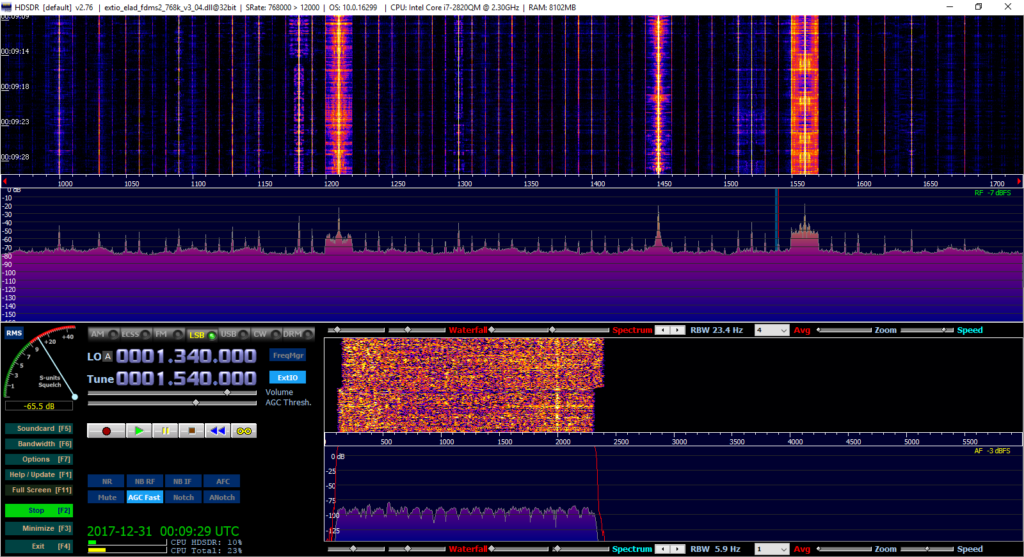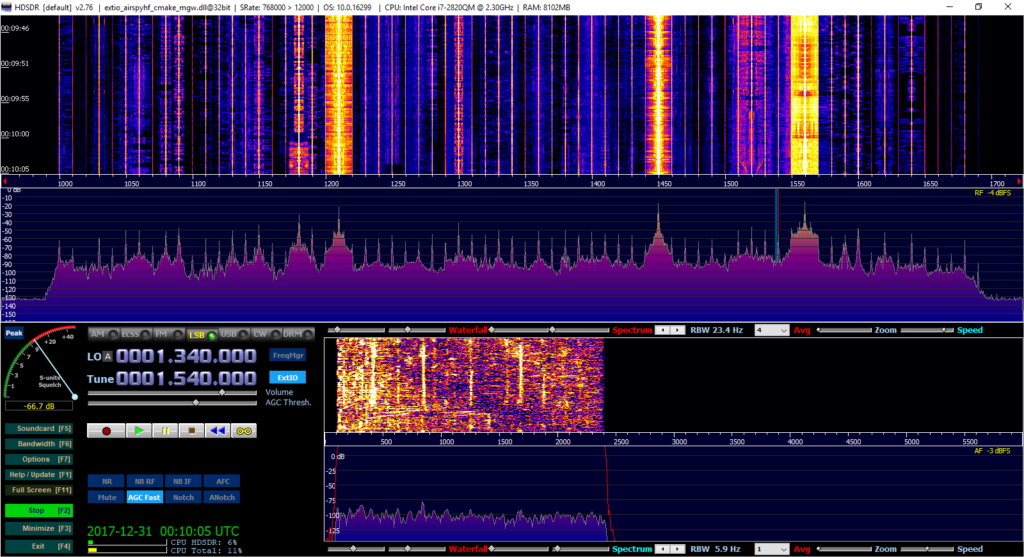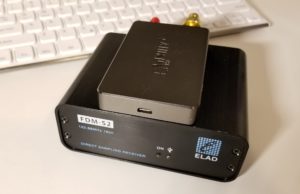The AirSpy HF+ is the new SDR on the block, but how does it compare to the Elad FDM-S2 which is more than 2-1/2 times its $199 price? My main interest is finding out how they compare in a very RF-quiet DXpedition setting, but today I compared the two briefly from my home in Puyallup, Washington (near Seattle).
The receivers were connected via a two-way antenna splitter to the output of a Wellbrook ALA1530S+ loop antenna. I monitored during mid-afternoon local time to ensure that all my MW locals in my suburban location would be at full power, for the best test of the radios’ overload performance. The Wellbrook active antenna is rather “hot” and sometimes overloads receivers during the daytime unless attenuation is added to the signal chain.
I noted there were no truly weak medium wave signals available during the session so comparing sensitivity wasn’t appropriate. However, the band was full of strong daytime MW signals.
It became apparent quickly that the upstart HF+ provides strong competition to the Elad SDR. Clearly, the AirSpy’s trade-off is bandwidth for raw performance at lower cost–approx. 660 kHz alias-free coverage versus about 6 MHz maximum for the Elad.
Using the same center L.O. (local oscillator) frequency, short recordings were made with both receivers on the same receive frequency, same bandwidth, AGC setting, etc. To approximate the 660 kHz coverage of the HF+, I set the FDM-S2 to its 768 kHz sampling rate, the closest available setting to 660 kHz wide coverage.
Here are the results on 1540 kHz, just 10 kHz away from a strong signal on 1550:
AirSpy HF+ – 1540 kHz
Elad FDM-S2 – 1540 kHz
What’s wrong with the above audio picture? The FDM-S2 is clearly overwhelmed by the strong RF on the upper end of the MW band. Visually, the spectrum looked like this with the Elad:
Elad FDM-S2 waterfall/spectrum (1540 kHz)

The noise floor rose by approximately 20 dB due to the overloading. The HF+ showed a normal waterfall and spectrum display while tuning 1540 kHz:
AirSpy HF+ waterfall/spectrum (1540 kHz)

Let’s listen to two more audio clips, this time from 720 kHz which is adjacent to very strong 710 KIRO, the ESPN affiliate in Seattle:
AirSpy HF+ – 720 kHz
Elad FDM-S2 – 720 kHz
This time the difference is subtle, but I think you’ll agree there is a greater amount of “crunchy” background distortion noise on the FDM-S2 recording. I found this to be the case in each instance where I compared receivers on frequencies adjacent to strong locals.
I no longer own a Perseus SDR, but that receiver handles the entire MW band at this location without overload using the same Wellbrook ALA1530S+ loop.
I’d like to emphasize that these were brief, somewhat casual AirSpy HF+ vs. Elad FDM-S2 tests. I expect that in a more forgiving RF environment, both receivers will be equally adept and digging out weak weak and challenging DX signals. I plan to investigate this very scenario in a few weeks at a quiet location on the Oregon coast.
Side note: I have two HF+ units and they can operate concurrently without problems for full medium wave band coverage with HSDSR software, even when both are recording IQ WAV files.
Guy Atkins is a Sr. Graphic Designer for T-Mobile and lives near Seattle, Washington. He’s a regular contributor to the SWLing Post.


Regarding the LW performance of the Airspy HF+: my unit is less sensitive on LW than my RSP1a or an Eton E1. Right now I am listening to BBC Radio 4 on 198 kHz on my Eton E1. The station is weak but audible, but the HF+ receives absolutely nothing. Also it seems like even though it is advertised to tune as low as 9 kHz, my HF+ is deaf below 20 kHz or so. Not a big issue for me, although it was fun to discover the Russian Alpha signals with my RSP1a: https://youtu.be/UtIi4FdLfuw
Thanks for the comparison, Guy. I’m currently using an SDRPlay RSP2 with a Wellbrook 1530LN and I don’t normally have overload problems. What I do have is MW/LW images cropping up all over my favourite part of the spectrum, which is 10KHz to 500KHz. I can cure it completely by inserting suitable LPF’s, but I’d love to hear how the HF+ performs without external filters in this area of the band.
Hi Andy, I also have the LNP version of the ALA1530 and that antenna doesn’t normally result in overload problems for my SDRs either. The S+ version is the one with more gain affecting medium wave, evidently.
I just did a quick daytime test of long wave here, and the HF+ reception revealed a few MW breakthrough signals on the lower part of the band (78, 86, and 162 kHz). They were weak to moderate in strength. The worst was from a local that’s currently being received on its 1550 kHz channel with S-9+60 dB (-13.5 dBm) strength, however! The FDM-S2 has raspy noise peaks and weak audio from these stations. However, this was just a quickie daytime check; I’ll need to give long wave another investigation at night.
I wonder how the RSP2 set at 500kHz compares to the HF+. Might be a worthwhile review, if anyone who has both could report.
Very interesting demonstration, Guy, nicely done! I use my FDM-S2 with a Wellbrook ALA-1530LNP and I always have to turn on the input attenuator via the FDM-SW2 software to keep the FDM-S2 from overloading with that antenna. Can you do this with the HDSDR application?
Are you using a commercial signal splitter? I’ve used a Mini-circuits ZSC2-1 splitter with mostly positive results.
Hi Chuck,
I also have a ALA1530LNP model, but I usually save that for DXpedition use. When used at home however, it doesn’t overload the Elad to the extent the ALA1530S+ model does. Adding attenuation, either external or via software typically takes care of the problems. HDSDR doesn’t have a software attenuation setting, unless I’ve overlooked it.
I also have Mini-Circuits splitters, plus a homebrew one that uses a tried-and-true simple circuit designed by MW DXer Nick Hall-Patch. This design was written up in one of the editions of the popular “Fine Tuning” series of books some years ago. This splitter works identical to the Mini-Circuits model when I’ve compared them.
73, Guy
While you’re still in the suburban environment, how are frequencies below 540 khz impacted by your local mw broadcast stations? That appears to be one of the big selling points of the HF+.
Hi Kevin,
Thanks for the idea to check out longwave! I will have to give this a try and report back.
Regards, Guy
Fascinating, Guy! Like you, I’ve found the HF+ a very capable MW receiver.
So you’re able to run two instances of HDSDR simultaneously and record I/Q from both HF+ units with no issues? Excellent.
Out of curiosity, how is you PC configured? What type of processor?
Cheers,
Thomas
Hi Thomas,
Yes, two instances of HDSDR run fine even when both are recording WAV files to the same hard drive. You just need to launch each HDSDR program from different file locations (folders) and have the HF+ EXTIO .dll file within each folder. I describe the setup in this Groups.io forum post: https://airspy.groups.io/g/main/topic/dual_hf_receivers_working/7706572?p=,,,20,0,0,0::recentpostdate%2Fsticky,,,20,2,0,7706572
I’ve done this with full success on two different laptops: one has an Intel i-5 @1.7GHz CPU and 4GB RAM with a small SSD, and the other is a more powerful Intel i-7 @2.5GHz with 8GB RAM. Both have the latest Windows 10 OS.
By the way, I measured current draw of the HF+ on the USB port at 325ma, so they work fine on USB 2.0 ports.